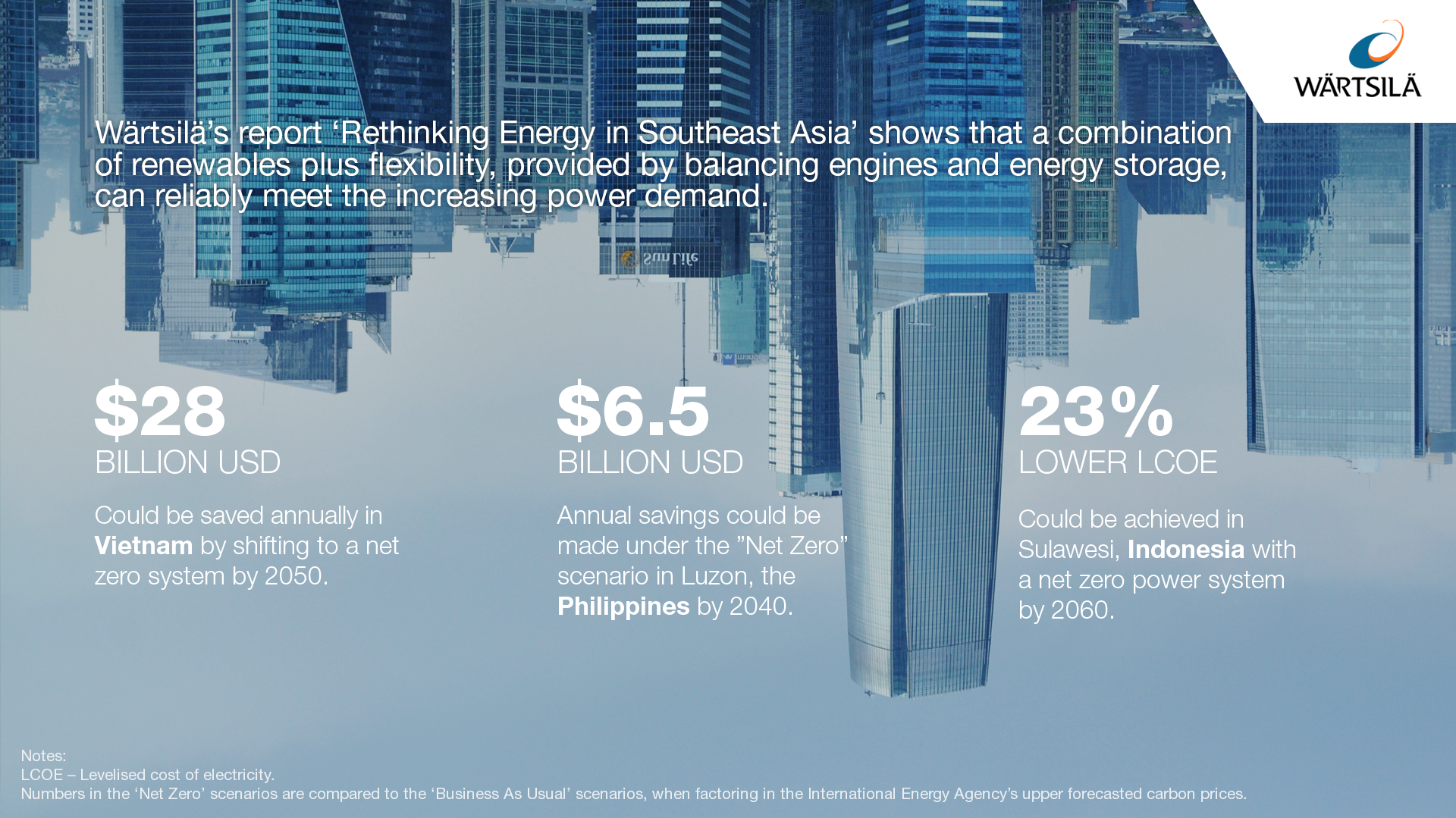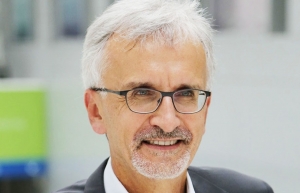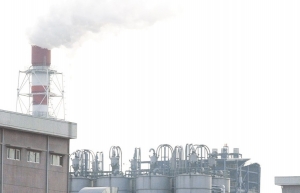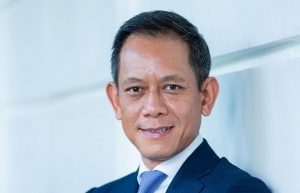Vietnam's smooth transition to net zero by 2050
 |
The modelling, published in Rethinking Energy in Southeast Asia, shows that a combination of renewables plus flexibility, provided by balancing engines and energy storage, can reliably meet Vietnam’s increasing power demand, which has risen at around 10 per cent per year in the last decade, faster than all other Southeast Asian countries.
Critically, when factoring in the International Energy Agency’s upper forecasted carbon prices, the study shows that the LCOE in the net zero power system is at least 20 per cent lower than in the business-as-usual (BAU) scenario of the modelling which did not restrict emissions.
Wärtsilä modelled four scenarios for the energy transition in Vietnam by 2050. The first – the BAU scenario – had no restrictions on emissions. Under this scenario, Vietnam would release 320 million tonnes of CO2 emissions by 2050, a three-fold increase in 2020, putting net zero well out of reach.
The report also modelled a scenario where emissions are reduced by 50 per cent by 2050, compared to the BAU scenario, as well as a scenario demanding emissions are reduced by 80 per cent by 2050 and another where the power system operates with net zero emissions by 2050.
The modelled scenarios all agree that flexibility, in the form of energy storage and balancing engines, is the crucial technological fix to enable renewable energy to become the dominant source of power. In every scenario, 7GW of balancing capacity is needed by 2030 for the system to meet peak demand. To reach net zero by 2050, Vietnam will need to install a total of 87GW of balancing capacity.
The findings show that building a net zero system would enable Vietnam to cut its LCOE by 20 per cent and avoid nearly $28 billion per year in forecasted carbon taxes by 2050. Meanwhile, renewables (including hydro, solar, wind, and bioenergy) should provide almost half of Vietnam’s power generation by the end of 2030.
Other key findings include 7GW of grid balancing engines being needed by 2030 to balance its new renewables; and up to 1GW of short-duration battery energy storage (1-2 hours), which should be installed by 2035.
To reduce 80 per cent of Vietnam’s emissions, renewables should provide 76 per cent of the power generation by 2050 to achieve a net zero power system. Investments in renewables and flexible generation would make it possible for Vietnam to phase out most coal capacity by 2040.
| In the net zero scenario of the report, a 646GW system is built by 2050 which, aside from creating enough power for Vietnam’s growth, would provide excess electricity to produce 52TWh of green hydrogen. |
Thanh Pham, country manager of Wärtsilä Energy in Vietnam said, “The results of the study show that the opportunity of a generation is in reach for Vietnam’s energy leaders. By creating a renewable and scalable power system, Vietnam can address the new normal of fossil fuel volatility and emission constraints while creating future growth, jobs, and prosperity.
Pham added, “Decarbonisation is a multi-year process, demanding stringent planning, but Vietnam’s aim to become a net zero economy is viable if the power sector takes the necessary actions today,” he added.
By adopting flexibility and renewables at scale, Southeast Asia can also curb emissions and create the right conditions for new technologies – such as green hydrogen produced domestically through electrolysis – to be scaled up. In the net zero scenario of the report, a 646GW system is built by 2050 which, aside from creating enough power for Vietnam’s growth, would provide excess electricity to produce 52TWh of green hydrogen.
To achieve the major benefits of net zero power systems, Vietnam’s policymakers and regulators need to incentivise the addition of more flexible capacity, while creating a more competitive energy market. Wärtsilä recommends considerations for capacity planning and policy development.
Accordingly, Vietnam should recognise that inflexibility comes at a cost, for example in the form of higher fuel consumption or the need to curtail renewables (which cannot be fully utilised by inflexible power systems).
The country should encourage and plan for more flexible capacity through power system planning, regulations, and additional revenue mechanisms to ensure the financial viability of flexible assets.
In addition, it is important to establish well-functioning ancillary services and balance markets to support grid stability and renewable integration.
Another key area is designing the next generation of power purchase agreements so that incentives for flexibility are built-in to the agreements to encourage and effectively value operational flexibility.
In the long term, Vietnam should develop competitive wholesale markets with real-time and short-interval pricing that better reflects the reality of the changing power market.
 | Private sector expected to support the green growth model in Vietnam Last year Vietnam made a remarkable commitment to achieve net-zero carbon emissions by 2050. Patrick Lenain, senior associate of the Swiss-based Council on Economic Policies, shares some recommendations to encourage the private sector’s role in this ambitious target. |
 | Backing up Vietnam’s COP26 goals Vietnam’s strong commitment to reduce greenhouse gas emissions over the next few decades is receiving major support from the international community. |
 | Ensuring energy efficiency through power monitoring In just the past 10 years, energy prices in Europe have risen an average of 19 per cent. At the same time, a growing number of companies need to become greener – and also want to do so – in order to succeed. Add to this the fact that in the wake of the energy transition and the global climate protection agreement, government regulations are calling for ever-higher efficiency standards. |
What the stars mean:
★ Poor ★ ★ Promising ★★★ Good ★★★★ Very good ★★★★★ Exceptional
Related Contents
Latest News
More News
- Vietnam’s forest carbon credits draw global interest (December 05, 2025 | 17:41)
- Coro Energy to launch BESS Pilot in Vietnam (December 04, 2025 | 15:12)
- Vietnam strengthens energy storage pathway (December 04, 2025 | 15:05)
- Women take leading role in agriculture and food systems (December 03, 2025 | 19:04)
- Experts highlight unpaid care work as key barrier to gender equality (December 03, 2025 | 15:15)
- Vietnam sets pace for dual transition in industry and trade (December 03, 2025 | 14:12)
- Harnessing technology for a sustainable future in Vietnam (December 03, 2025 | 12:17)
- Sustainability efforts on right track through policy and tech (December 03, 2025 | 12:05)
- Hanoi symposium highlights gender equality research and policy (December 03, 2025 | 12:00)
- The march to productivity and environmental sustainability (December 03, 2025 | 09:17)

 Tag:
Tag:






















 Mobile Version
Mobile Version